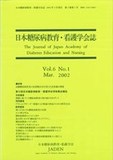Japanese
English
- 有料閲覧
- Abstract 文献概要
- 参考文献 Reference
- サイト内被引用 Cited by
本研究は,高齢糖尿病患者の食事療法にかかわる生活意識,および食事療法実行度と生活意識との関係を壮年期患者との比較において明らかにすることを目的とした.調査対象は外来通院中の65歳以上の2型糖尿病患者79名,40~64歳の壮年期患者71名とし,調査票を用いた構成的面接法で実施した.有効回答数は149名(99.3%)で男性52名,女性は97名だった.平均ヘモグロビンA1cは老年期・壮年期とも7.0%であった.食事療法実行度の自己評価最高得点は,高齢糖尿病患者・壮年期患者ともに5点,自己評価平均は各々3.2,3.1で両群に有意な差はみられなかった.食事療法ができそうと思う高齢患者は壮年期患者よりも少なく,できそうという思いと実行度には老年期・壮年期ともにかなりの相関(τ=0.42,τ=0.50)がみられた.さらに,老年期では家族や社会に対する責任が多いほど実行度は高く(τ=0.23~τ=0.25),壮年期では逆に低かった(τ=-0.24).
The aims of this study were (i) to compare the characteristics of life style consciousness between elderly diabetics and adult diabetics and (ii) to clarify the relationship between dietary compliance and life style awareness amongst the two groups. Type 2 diabetic outpatients made up the research subjects for the study. They were divided into two groups which consisted of 79 subjects aged over 65 and 71 adults aged between 40 to 64. Structured interview techniques were used. The response rate was 99.3%consisting of 52 male respondents and 97 females. The average HbA1cfor both the adult and elderly groups was 7.0%with no significant difference found between the two. For self-appraisal compliance, the mean score was 3.2 for the elderly participants and 3.1 for the adult with no significant difference between the two groups. The more an elderly diabetic had familial and social responsibilities, the higher the rate of compliance (τ=0.23 \sim τ=0.25), while for the adult group the opposite was the case (τ=-0.24). Additionally, there were fewer elderly diabetics who thought that they could comply with the specified diet than there were in the younger group. There was a correlation in the elderly and adult groups in attitudes towards being able to comply and actual compliance rate (τ=0.42,τ=0.50).
Copyright © 2002, Japan Academy of Diabetes Education and Nursing. All rights reserved.


